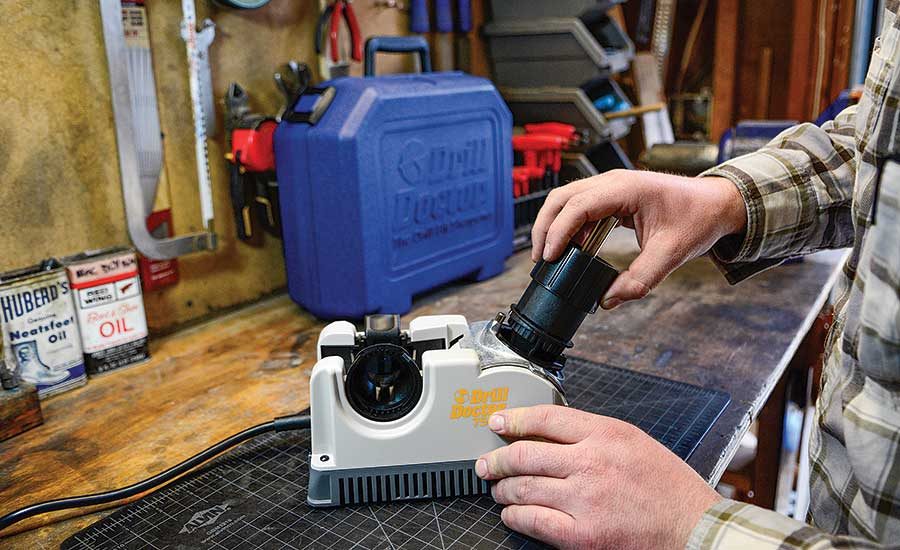A quick primer on drill bits
Knowing which bit is appropriate for a job can save time and money.

Bits can dull throughout the workday, and being able to sharpen them right at the jobsite keeps work moving and ensures fast, precise holes. Photo credit: Drill Doctor

Keeping drill bits sharp helps professionals do their jobs better and faster.

Different drill bits are designed for very different applications, and using the right drill bit for the job will help plumbers save time and money on the job site.



Between blueprints and piping configurations, every job you encounter as a plumber has its own distinct set of challenges. One component that you should always be clear on: Your tools.
One of the most common tools a plumber uses is a drill. This quick guide will help any plumber sharpen their knowledge of drill bits.
Types of drill bits
There are four main types of drill bit materials:
-
High-speed steel bits — Generally used to drill wood, PVC, aluminum and cold-rolled steel.
-
Cobalt bits — For tough, high-tensile metals. These have a higher heat resistance than steel and are usually split point.
-
Masonry bits — Used for concrete, mortar, ceramic, tile, brick and stone, these are mild steel with a carbide tip. Carbide bits are used to drill harder alloys; because of carbide’s dense structure, users can push the drill bits harder than they can with steel bits.
-
Tin-coated bits — Surface treated for higher heat resistance, low friction and high surface hardness.
A common material plumbers work with is PVC pipe. Because it is considered a soft plastic, you can use a high-speed steel bit to drill a small hole. Matching the correct drill bit to the material being drilled into can make or break the success of a project.
Standard point vs. split point
The shaft of a drill bit has two curving grooves — called flutes — that pull debris from the hole being drilled.
In a standard point, the tip is smooth and comes to a slight point. However, unless the material being drilled provides a solid amount of friction and the drill is perfectly perpendicular to the surface, the smooth standard point can slip off the target and gouge the material — an issue called “walking.”
The shaft of a good split-point bit features three grooves that lift away debris, allowing the user to drill holes faster and with a smaller chance of snags. These grooves continue all the way to the tip of the bit, where they cut into the tip’s cap, breaking the smoothness and creating a grooved bit tip.
Splitting the point creates a self-centering bit that more easily anchors itself in the material and keeps a bit on target, allowing the drill to cut with less pressure and eliminate walking.
Point angles
The two most common drill bit point angles are 118 degrees and 135 degrees. You can see the difference between the two in their shapes; a 118-degree bit has a smaller chisel, is steeper and more pointed.
The 118-degree bit is typically used for drilling into soft material, and cuts more aggressively. Although capable of penetrating steel, if used for this, the steeper cutting angle also will cause it to dull quicker.
A 135-degree bit is generally used for drilling into harder materials, because the pitch makes it easier to drill repeated holes into tougher material. This may come in handy for a plumber who is installing a bathroom sink or toilet and needs to drill through ceramic or tile.
The point of sharpening
Keeping drill bits sharp is essential for getting the job done right — and being able to sharpen them from anywhere is key. Bits can dull throughout the workday, and being able to sharpen them right at the jobsite keeps work moving and ensures fast, precise holes.
While sharpening drill bits by hand is a possibility, it takes a considerable amount of time, and requires excellent near vision. Instead, it’s recommended that plumbers sharpen drill bits on a tool specifically designed for the job. Drill sharpeners use a chuck to hold the bit at a correct, consistent angle, and an abrasive wheel or disc to sharpen the edge. Specialty sharpening tools can be found at large retailers and most local hardware stores.
The same tool can be used to sharpen high-speed, cobalt, and tin-coated drill bit types, but carbide tips require a sharpener with a diamond wheel.
Looking for a reprint of this article?
From high-res PDFs to custom plaques, order your copy today!









